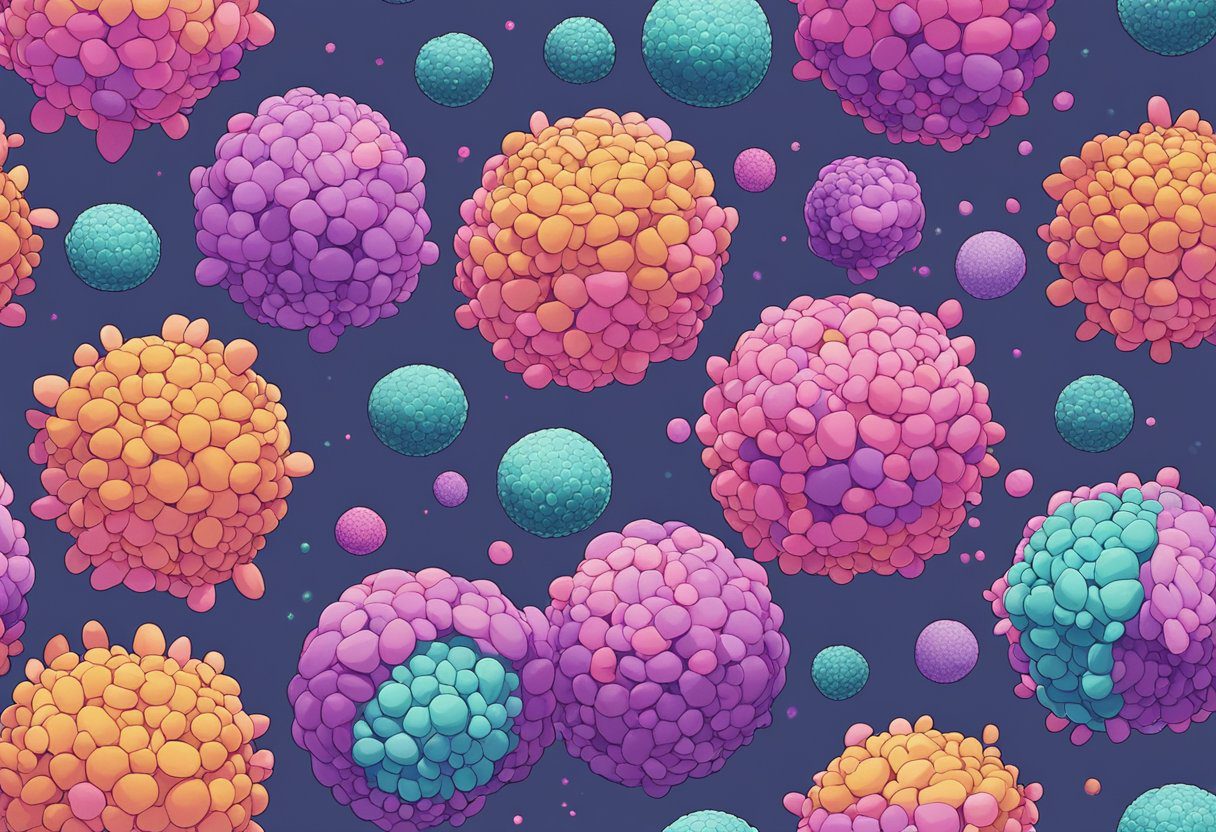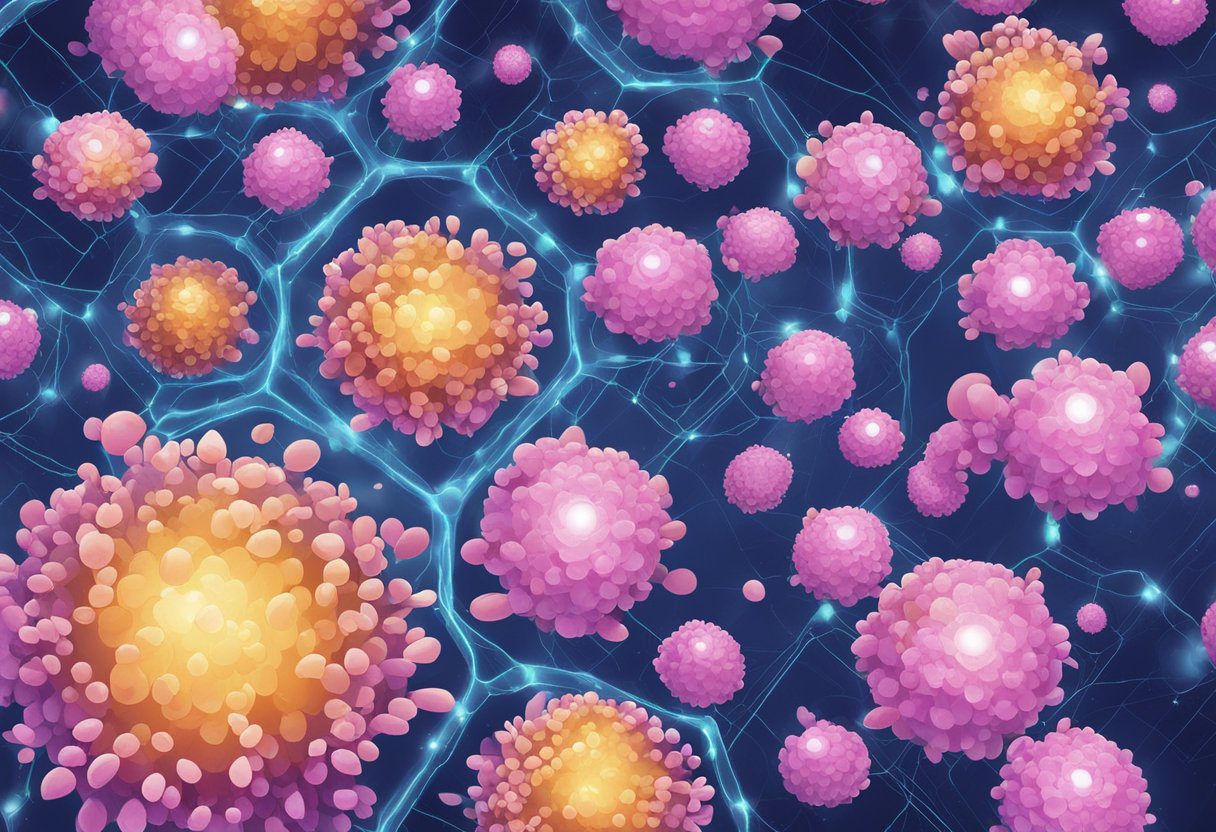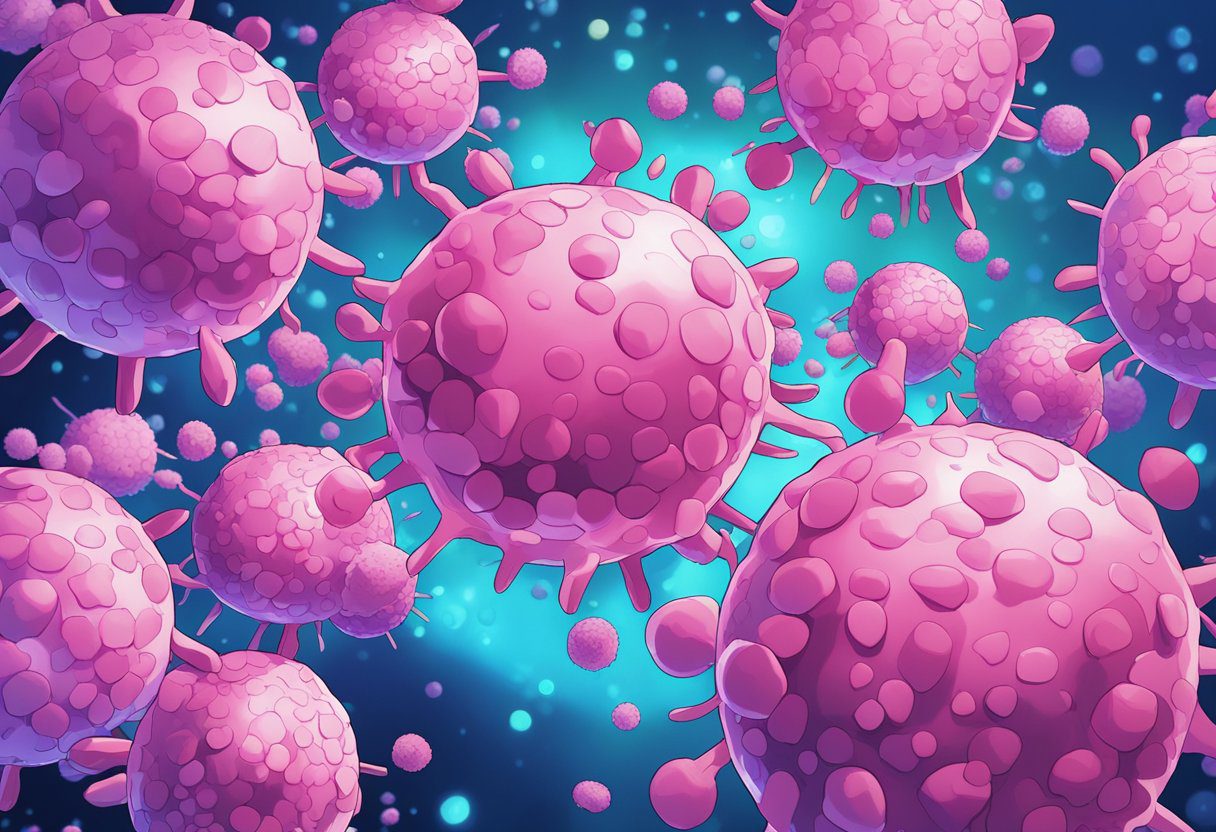Triple-negative breast cancer (TNBC) stands out as a distinct subtype of breast cancer due to its unique characteristics and the challenges it presents. Unlike other breast cancer types, TNBC does not express the estrogen receptor, progesterone receptor, or HER2 protein, which are common targets for treatment. This absence of receptors leads to fewer options for targeted therapy, making it a more difficult form of cancer to treat effectively.

TNBC typically affects younger women and is known to be more aggressive, with a higher likelihood of metastasis and recurrence. Additionally, it tends to grow and spread quicker than other types of breast cancer, which requires a more aggressive treatment approach. Understanding the biological underpinnings and the resulting implications of TNBC is critical for developing effective management strategies and improving patient outcomes.
Key Takeaways
- TNBC lacks receptors for estrogen, progesterone, and HER2, limiting targeted treatment options.
- It often affects younger women and is associated with higher aggression and risk of recurrence.
- TNBC requires a different treatment strategy due to its unique characteristics and behavior.
Understanding TNBC

Triple-negative breast cancer (TNBC) is distinct from other forms of breast cancer. This section breaks down what TNBC is, how it differs from other breast cancers, its unique genetic makeup, and the various subtypes it encompasses.
Defining TNBC
Triple-negative breast cancer (TNBC) refers to a type of breast cancer that lacks the three most common types of receptors known to fuel most breast cancers: estrogen receptors (ER), progesterone receptors (PR), and human epidermal growth factor receptor 2 (HER2). These receptors are not found on the surface of TNBC cancer cells, which means that hormone therapies and drugs that target HER2 are ineffective against TNBC.
TNBC Versus Other Breast Cancers
TNBC is more aggressive and has a higher probability of metastasis compared to hormone receptor-positive and HER2-positive breast cancers. Unlike these cancers, TNBC cannot be treated with hormone therapy or drugs targeting HER2 due to the absence of ER, PR, and HER2. Instead, treatment options primarily include chemotherapy, radiation, and surgery. Studies have indicated that TNBC may have lower survival rates compared to other breast cancer types.
Genetic and Molecular Characteristics
The genetic and molecular characteristics of TNBC include mutations in the BRCA1 and BRCA2 genes, which play a role in DNA repair. Cells with these mutations have difficulty repairing DNA, leading to more mutations and potential for cancer development. TNBC cells often exhibit diverse mutations and alterations in various signaling pathways, making them more complex and harder to treat.
Subtypes of TNBC
Research has revealed different subtypes of TNBC, such as basal-like, mesenchymal stem-like, and mesenchymal-like. Each subtype has a unique expression of biomarkers and involvement in specific molecular subtypes. Understanding these subtypes is essential for developing targeted therapies and personalized treatment approaches.
Risk Factors and Prevalence

Triple-negative breast cancer (TNBC) stands apart from other breast cancer subtypes due to distinct risk factors and epidemiological patterns. This section delves into shared risk factors, the influence of age and ethnicity on TNBC prevalence, and the associated genetic considerations.
Common Risk Factors
Several risk factors contribute to the likelihood of developing TNBC. These include genetic predispositions with mutations in BRCA1 and BRCA2 genes being significant contributors. Patients with these genetic mutations are at an increased risk of developing TNBC. Additionally, family history of breast or ovarian cancer can also heighten risk. Factors like obesity and lifestyle choices that contribute to general cancer risks are pertinent but are not TNBC specific.
Age and TNBC
The incidence of TNBC appears to be higher in women who are premenopausal. Typically, the risk of breast cancer increases with age, but TNBC is more prevalent among younger women, commonly those under the age of 50. Age thus serves as both a clinical cue for the likelihood of TNBC and a factor in prognosis.
Ethnicity and TNBC
Ethnicity plays a significant role in the prevalence of TNBC. Statistics show that black women are disproportionately diagnosed with TNBC compared to other ethnic groups. Furthermore, studies suggest black women also have a higher risk of mortality from TNBC. Genetic factors, access to genetic testing, and socioeconomic factors may all contribute to this elevated risk and deserve focused attention for intervention and support.
Diagnosis and Staging

The diagnosis and staging of triple-negative breast cancer (TNBC) are critical steps in determining the most effective treatment. This section covers the methodology used to detect TNBC and describes the process for classifying the cancer’s stage.
Detecting TNBC
To diagnose TNBC, doctors rely on various testing methods to identify the absence of hormone receptors that are typically present in other forms of breast cancer. A biopsy is the primary method where a sample of breast tissue is taken for meticulous laboratory analysis. During this examination, pathologists look for the presence of estrogen and progesterone receptors, as well as the HER2 protein. TNBC is confirmed when these receptors and proteins are not detected in the cancer cells. Additional imaging tests, such as mammograms and MRIs, can also be employed to observe the tumor’s structure and guide biopsy procedures.
Cancer Staging
Once TNBC is confirmed, staging follows to categorize the cancer based on its extent within the body. Staging helps assess whether the cancer is localized to the breast, has spread regionally to nearby lymph nodes, or has resulted in distant metastasis. The TNM system is frequently used, evaluating the size and extent of the Tumor (T), whether the cancer has spread to the Nodes (N), and the presence of Metastasis (M).
Cancer stages range from Stage 0, indicating non-invasive cancer, to Stage IV, which signifies cancer with distant metastasis. The progression from Stage I to Stage III typically reflects a move from small, localized tumors to larger, regional spread capable of involving multiple lymph nodes but not yet resulting in distant metastasis. Accurate staging is fundamental for TNBC as it informs the treatment strategy and provides insight into prognosis.
Treatment Approaches

The treatment approach for triple-negative breast cancer (TNBC) is distinct from other breast cancer types due to the absence of hormonal or HER2 receptors in TNBC cells. The strategies involve a combination of chemotherapy, localized treatments like surgery and radiation, and progressively, targeted therapies and immunotherapy. Clinical trials continue to play a critical role in the development of new treatments.
Chemotherapy
Chemotherapy remains a cornerstone in the treatment of TNBC, specifically due to the lack of hormone receptors that are present in other breast cancer types. Drugs like paclitaxel are commonly deployed to damage the DNA of cancer cells, leading to cell death. Chemotherapy can be administered before surgery (neoadjuvant) to shrink tumors and after surgery (adjuvant) to eliminate residual disease.
Surgery and Radiation
Surgery is often the first line of defense in the treatment of TNBC; options include a lumpectomy or mastectomy depending on the extent and location of the tumor. Post-surgery, radiation therapy is typically used to eradicate any remaining cancer cells in the breast or chest wall, significantly reducing the risk of recurrence.
Targeted Therapies
While traditional targeted therapies are limited due to the nature of TNBC, newer treatment options including poly (ADP-ribose) polymerase inhibitors (PARP inhibitors) and antibody-drug conjugates are showing promise for patients with specific genetic mutations. Immune checkpoint inhibitors have emerged to harness the patient’s own immune system to combat cancer cells.
Clinical Trials and Emerging Treatments
Clinical trials are an essential component of advancing TNBC treatment options. Many trials investigate the efficacy of novel immunotherapy drugs and combination therapies. Participation in clinical trials offers patients access to cutting-edge treatments and contributes to the broader understanding of TNBC.
Prognosis and Outcomes

Triple negative breast cancer (TNBC) is known for its distinct prognosis and outcomes when compared to other breast cancer types. This is largely due to its more aggressive nature and higher likelihood of recurrence and metastasis.
Survival Rates and Prognosis
TNBC typically has a lower survival rate than hormone receptor-positive breast cancers. Studies indicate that around 77% of patients with TNBC live at least five years after diagnosis, as compared to the 93% survival rate for other types of breast cancer. Prognosis for TNBC heavily depends on the stage at diagnosis and the effectiveness of the initial treatment.
Factors Influencing Prognosis
The prognosis for patients with TNBC is influenced by various factors including the size and extent of the tumor, the presence of distant metastasis, and overall health of the patient. Furthermore, genetic variations like BRCA mutations can affect the tumor response to treatment. The efficacy of chemotherapy, as well as the patient’s response to it, also plays a critical role.
Recurrence and Metastasis
TNBC has a higher recurrence rate, with most recurrences happening within the first 3 years after treatment. The risk of metastasis is particularly concerning with TNBC; if the cancer metastasizes, commonly to the brain or lungs, it significantly worsens the prognosis. Managing treatment side effects efficiently is also essential to improve quality of life and reduce the chances of recurrence.
Living with TNBC

Living with triple-negative breast cancer (TNBC) presents unique challenges, such as dealing with the side effects of treatment, requiring psychological support, and the necessity for diligent follow-up care. Knowledge and resources are essential for managing these aspects of the disease.
Managing Treatment Side Effects
Treatment for TNBC often involves chemotherapy, which can bring about a range of side effects. Patients typically experience fatigue, nausea, and may be at higher risk for infections due to lowered white blood cell counts. Self-care practices such as adequate rest, nutrition, and hygiene are crucial. Healthcare providers may also recommend medications to mitigate side effects and suggest routine monitoring of one’s overall health to manage and alleviate treatment impacts effectively.
Psychological and Emotional Support
The psychological burden of TNBC can be significant, warranting emotional support. Support groups, counseling, and therapy sessions can provide comfort and coping strategies. Mental health professionals can help patients navigate feelings of anxiety or depression, which may arise from the diagnosis or treatment. Maintaining strong social support networks, including family and friends, plays a critical role in supporting overall mental health.
Long-term Surveillance and Follow-up Care
After completing treatment, long-term surveillance is paramount to monitor for any signs of recurrence. Regular follow-up appointments, which may include physical exams, imaging tests, and blood work, are critical for early detection of any changes in health status. Patients should remain vigilant about their overall health and practice ongoing self-care. Physicians may also discuss lifestyle modifications that can potentially reduce the risk of recurrence and support general well-being.
Frequently Asked Questions

The following questions aim to clarify the peculiarities and concerns surrounding triple-negative breast cancer (TNBC), a subtype distinct from other breast cancers due to its aggressive nature and limited treatment options.
What characteristics distinguish triple-negative breast cancer from other breast cancer subtypes?
Triple-negative breast cancer lacks the three receptors commonly found in other breast cancers: estrogen, progesterone, and HER2/neu. The absence of these receptors means that hormone therapies and drugs that target HER2 are ineffective against TNBC.
Which factors contribute to the development of triple-negative breast cancer?
Risk factors for developing TNBC include genetic mutations such as BRCA1, being of younger age, and belonging to certain ethnic groups, such as African American. Lifestyle and environmental factors also play a role, though they are less distinctly correlated with TNBC than with other breast cancer types.
What are the typical symptoms associated with triple-negative breast cancer?
Symptoms of TNBC are similar to other forms of breast cancer and can include a breast lump, changes to the skin over the breast, and nipple discharge. However, TNBC may have a higher probability of spreading and metastasizing at an earlier stage.
Why is triple-negative breast cancer considered more challenging to treat than other types of breast cancer?
TNBC’s lack of hormone receptors and HER2 protein makes it unresponsive to some of the most effective therapies available for other breast cancer types. As a result, chemotherapy is often the mainstay of treatment, which can be less targeted and associated with more side effects.
How does the prognosis for triple-negative breast cancer compare to other breast cancer subtypes?
The prognosis for TNBC is generally less favorable than for other types of breast cancer, due to its aggressive growth pattern, tendency for early recurrence, and limited treatment options. However, outcomes vary greatly depending on the stage at diagnosis and response to treatment.
Can you describe the different subtypes within triple-negative breast cancer?
Despite being classified as a single group, TNBC is heterogeneous, with various subtypes including basal-like and mesenchymal. These subtypes differ in their molecular characteristics, which may influence their behavior and response to treatment. Research into these distinctions is ongoing, offering hope for more effective therapies in the future.